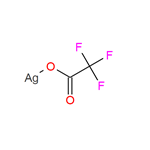light beige to grey crystalline powder
Silver Trifluoroacetate functions as a catalyst in the synthesis of cyclobutene-fused azepines/dihydropyridines.
Silver trifluoroacetate is the silver salt of trifluoroacetic acid and is used as a Lewis acid catalyst. It is used as an important raw material for the preparation of triethylsilyl trifloroacetate and triphenylmethyl trifluoroacetate. Further, it is used as a catalyst in the preparation of 4-iodoveratrole from veratrole by reacting with iodine.
Silver trifluoroacetate is prepared by the reaction of silver oxide and trifluoroacetic acid.
Reaction equation: Ag2O+2CF3COOH→2CF3COOAg+H2O
Reaction: 187g (0.81mol) of silver oxide was weighed and suspended in 200mL of water, and 177g (1.55mol) of trifluoroacetic acid was added. After filtration, the filtrate was evaporated to dryness under reduced pressure. The residue was extracted with ether in a Soxhlet extractor. Alternatively, dissolve the residue in 1.2L of ether and filter through a thin layer of activated carbon. After distilling off the ether, 300g of the product was obtained with a yield of 83%.
The extract is filtered and evaporated to dryness, then the powdered residue is completely dried in a vacuum desiccator over silica gel. Its solubility in Et2O is 33.5g in 750mL. It can be recrystallised from *C6H6 (solubility is: 1.9g in 30mL of *C6H6, and 33.5g will dissolve in 750mL of anhydrous Et2O). [Traynham & Dehn J Org Chem 23 1545 1958, Haszeldine J Chem Soc 584 1951.] Store it in the dark. It is also soluble in trifluoroacetic acid (15.2% at 30o), toluene, o-xylene and dioxane [Hara & Cady J Am Chem Soc 76 4285 1954]. [Beilstein 2 IV 461.]


